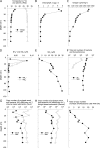High abundance of ammonia-oxidizing Archaea in coastal waters, determined using a modified DNA extraction method
- PMID: 20118363
- PMCID: PMC2849251
- DOI: 10.1128/AEM.02692-09
High abundance of ammonia-oxidizing Archaea in coastal waters, determined using a modified DNA extraction method
Abstract
Molecular characterizations of environmental microbial populations based on recovery and analysis of DNA generally assume efficient or unbiased extraction of DNA from different sample matrices and microbial groups. Appropriate controls to verify this basic assumption are rarely included. Here three different DNA extractions, performed with two commercial kits (FastDNA and UltraClean) and a standard phenol-chloroform method, and two alternative filtration methods (Sterivex and 25-mm-diameter polycarbonate filters) were evaluated, using the addition of Nitrosopumilus maritimus cells to track the recovery of DNA from marine Archaea. After the comparison, a simplified phenol-chloroform extraction method was developed and shown to be significantly superior, in terms of both the recovery and the purity of DNA, to other protocols now generally applied to environmental studies. The simplified and optimized method was used to quantify ammonia-oxidizing Archaea at different depth intervals in a fjord (Hood Canal) by quantitative PCR. The numbers of Archaea increased with depth, often constituting as much as 20% of the total bacterial community.
Figures



Similar articles
-
Spatial distribution of Bacteria and Archaea and amoA gene copy numbers throughout the water column of the Eastern Mediterranean Sea.ISME J. 2009 Feb;3(2):147-58. doi: 10.1038/ismej.2008.94. Epub 2008 Sep 25. ISME J. 2009. PMID: 18818711
-
Determining the distribution of marine and coastal ammonia-oxidizing archaea and bacteria using a quantitative approach.Methods Enzymol. 2011;486:205-21. doi: 10.1016/B978-0-12-381294-0.00009-2. Methods Enzymol. 2011. PMID: 21185437
-
Nitrosopumilus maritimus gen. nov., sp. nov., Nitrosopumilus cobalaminigenes sp. nov., Nitrosopumilus oxyclinae sp. nov., and Nitrosopumilus ureiphilus sp. nov., four marine ammonia-oxidizing archaea of the phylum Thaumarchaeota.Int J Syst Evol Microbiol. 2017 Dec;67(12):5067-5079. doi: 10.1099/ijsem.0.002416. Epub 2017 Oct 16. Int J Syst Evol Microbiol. 2017. PMID: 29034851
-
Biases in community structures of ammonia/ammonium-oxidizing microorganisms caused by insufficient DNA extractions from Baijiang soil revealed by comparative analysis of coastal wetland sediment and rice paddy soil.Appl Microbiol Biotechnol. 2013 Oct;97(19):8741-56. doi: 10.1007/s00253-013-5169-2. Epub 2013 Aug 24. Appl Microbiol Biotechnol. 2013. PMID: 23974369
-
Ammonia-oxidizing archaea involved in nitrogen removal.Water Res. 2009 Apr;43(7):1801-9. doi: 10.1016/j.watres.2009.01.016. Epub 2009 Jan 31. Water Res. 2009. PMID: 19232671 Review.
Cited by
-
Composition of Archaea in seawater, sediment, and sponges in the Kepulauan Seribu reef system, Indonesia.Microb Ecol. 2014 Apr;67(3):553-67. doi: 10.1007/s00248-013-0365-2. Epub 2014 Jan 30. Microb Ecol. 2014. PMID: 24477923
-
Nitrosomonas supralitoralis sp. nov., an ammonia-oxidizing bacterium from beach sand in a supralittoral zone.Arch Microbiol. 2022 Aug 17;204(9):560. doi: 10.1007/s00203-022-03173-5. Arch Microbiol. 2022. PMID: 35978059
-
Enrichment and characterization of ammonia-oxidizing archaea from the open ocean: phylogeny, physiology and stable isotope fractionation.ISME J. 2011 Nov;5(11):1796-808. doi: 10.1038/ismej.2011.58. Epub 2011 May 12. ISME J. 2011. PMID: 21562601 Free PMC article.
-
Microbial activity in the marine deep biosphere: progress and prospects.Front Microbiol. 2013 Jul 11;4:189. doi: 10.3389/fmicb.2013.00189. eCollection 2013. Front Microbiol. 2013. PMID: 23874326 Free PMC article.
-
Archaeal community variation in the Qinhuangdao coastal aquaculture zone revealed by high-throughput sequencing.PLoS One. 2019 Jun 21;14(6):e0218611. doi: 10.1371/journal.pone.0218611. eCollection 2019. PLoS One. 2019. PMID: 31226149 Free PMC article.
References
-
- Agogué, H., M. Brink, J. Dinasquet, and G. J. Herndl. 2008. Major gradients in putatively nitrifying and non-nitrifying Archaea in the deep North Atlantic. Nature 456:788-791. - PubMed
-
- Baltar, F., J. Arístegui, J. M. Gasol, S. Hernández-León, and G. J. Herndl. 2007. Strong coast-ocean and surface-depth gradients in prokaryotic assemblage structure and activity in a coastal transition zone region. Aquat. Microb. Ecol. 50:63-74.
-
- Beman, J. M., B. N. Popp, and C. A. Francis. 2008. Molecular and biogeochemical evidence for ammonia oxidation by marine Crenarchaeota in the Gulf of California. ISME J. 2:429-441. - PubMed
-
- Boström, K. H., K. Simu, A. Hagström, and L. Riemann. 2004. Optimization of DNA extraction for quantitative marine bacterioplankton community analysis. Limnol. Oceanogr. Methods 2:365-373.
-
- Bower, P. A., C. O. Scopel, E. T. Jensen, M. M. Depas, and S. L. McLellan. 2005. Detection of genetic markers of fecal indicator bacteria in Lake Michigan and determination of their relationship to Escherichia coli densities using standard microbiological methods. Appl. Environ. Microbiol. 71:8305-8313. - PMC - PubMed
Publication types
MeSH terms
Substances
LinkOut - more resources
Full Text Sources

